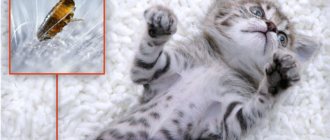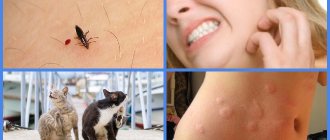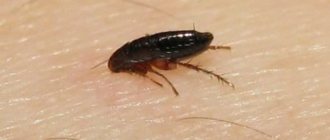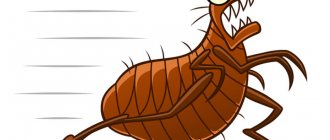Fleas are parasites that live in all countries and regions. Their food is the blood of mammals, including humans. There are mainly two species parasitizing cats and dogs: the dog flea (Ctenocephalides canis) and the cat flea (Ctenocephalides felis). Moreover, they do not need to stay on one host; fleas move from one host to another. Both species live on both cats and dogs and often attack humans.
Rat and human fleas are common in cities, but there are hundreds of other species in nature. Let's take a closer look at the dog flea. Can dog fleas bite humans, in what situations are they transmitted to humans, and what are the differences between dog and cat fleas.
What do dog fleas look like?
Like the rest of their order, dog fleas go through four stages in their life cycle. All stages, except the imago, live outside the host: in carpets, crevices, and animal bedding.
Adult dog fleas are reddish-brown in color and reach 2-4 mm in length. Of the three pairs of legs, the last powerful pair is the jumping pair. The dog flea is wingless, its body is laterally flattened, covered with a hard, shiny exoskeleton, adapted for movement in the animal’s fur. The design of the oral apparatus is adapted for piercing the host's skin and sucking blood. The height of the jumps reaches 25 cm, length – 40 cm.
Products for getting rid of fleas
Special products for getting rid of fleas are available in different forms. All of them have their own application features, disadvantages and advantages.
Table 3. Types of flea products and features of their use
| Release form | Features of application | pros | Minuses | Popular brands | Photo |
| Spray | Suitable for adult dogs. The owner better wear a mask | Very fast result. Long intervals between relapses | May get into the dog's eyes, respiratory tract, and mouth. Prohibited for certain diseases, consult a veterinarian | Hartz, Frontline | Hartz |
| Drops | Apply to the withers according to the instructions | Reliably gets rid of adult fleas. They work as a preventive measure. Suitable for dogs with contraindications to sprays | Often require more than 1 application. May cause local irritation | Stronghold, Advantage, Frontline | Frontline |
| Shampoo | Used for bathing puppies and adult dogs. It is better for a person to wear gloves. Needs to be washed off thoroughly | Suitable for treatment and prevention | More than 1 application per treatment is required. There are types for sensitive skin | Beaphar, Mr. Bruno, "Clandestine" | Beaphar |
| Tablets and injections | Only by doctor's prescription. As a rule, they are prescribed for complications such as infections, severe poisoning, and helminthic infections. | Effective in advanced cases | The most aggressive treatment method | "Nexgard", "Comfortis", "Advocate", "Bravecto" | "Comfortis" |
| Powder | You need to rub it into the fur for a while. Then rinse thoroughly | Ease of application. Does not get into eyes, mouth, nose | It is necessary to ensure that the pet does not lick the powder. Suitable for sensitive skin | “Clandestine”, “Insectal”, “Barrier”, Trixie | "Barrier" |
| Collars | Worn around the dog's neck when walking | Safe for puppies and adults; Can't be licked off; Suitable for prevention, repels fleas well | Virtually no results in terms of treatment | Hartz, Beaphar, “Clandestine”, “Bars” | "Celandine" |
The choice of form is best done after consultation with a veterinarian. Sometimes the participation of several species is required at once.
Video - How to remove fleas from a dog at home?
How do dog fleas reproduce?
Dog fleas lay eggs in the fur of animals, after which they spill out into the external environment (about 60% of laid eggs fall out within the first two hours). Flea eggs resemble chicken eggs, only on a micro scale, oval in shape, milky white in color, size 0.2-0.5 mm.
The larval stage of the dog flea resembles an earthworm half a centimeter long, without legs, but with a wide mouth. Initially, the larva is white, but through the translucent walls of the body the intestines are visible, where the eaten feces of adult fleas (digested blood) fall, so the nymph soon turns brown. When moving to the next stage, it weaves a whitish cocoon around itself and turns into a pupa. And an adult flea is already emerging from the cocoon.
Adult fleas are only the visible tip of the iceberg, 5% of the colony, which includes all 4 stages. Therefore, the fight against fleas, in addition to the destruction of biting adults, involves the destruction of larvae and eggs indoors.
Briefly about fleas
Fleas are blood-sucking, wingless insects that go through a full cycle of transformation. So, first, the adult female literally shoots the eggs (this method of laying increases the likelihood of survival). After about two weeks, the eggs hatch into larvae, which molt three times and then pupate. An adult individual emerges from the cocoon.
There are many types of fleas, and they are grouped into 15 families. But some varieties are especially common and even have medical and economic importance. Thus, cat, dog, rat, human, rabbit, and chicken fleas are well known and studied.
The flea's body is brown in color, flattened on the sides, and the abdomen is much wider than the other parts. Of the three pairs of limbs, the last are the most powerful and long; with their help, parasites jump and move considerable distances.
Parasites feed only on the blood of their host, and the oral apparatus is completely adapted to this type of feeding. It belongs to the piercing-sucking type and allows you to first pierce the skin and then suck out the blood. Moreover, the bites of such parasites are quite painful. And the larvae feed somewhat differently, eating biological secretions (for example, secretions secreted by the sebaceous glands) and keratinized particles of the epidermis.
How are cat fleas different from dog fleas?
In both cats and dogs, the cat flea (Ctenocephalides felis) is more common than the dog flea (Ctenocephalides canis). According to one study, cat fleas account for 95% of flea infestations in these animals. But the naked eye cannot distinguish one from the other.
Upon careful comparison under a microscope, you will notice that dog fleas have a steep forehead, while cat fleas have a flat forehead. The proboscis of the dog flea is longer, the stigmata of the abdominal tergites are larger, and the manubrium of the genital claw is more broadened in the male. Due to these differences, dog fleas look more massive.
Otherwise, these two species are similar to each other. The life cycle, the timing of development of eggs and larvae, the structure of the exoskeleton covered with spines and bristles - these and other features unite dog and cat fleas. Both are dangerous because they carry infectious diseases: plague, typhus, ctenocephalosis, as well as flatworms and other endoparasites.
Species and danger to humans
Scientists have identified about 2,000 species of fleas. Temperate climates are home to parasites that live on cats, dogs, rats, rabbits, and herbivores, all of which can target humans.
Human flea bites are more painful than bedbug bites because the latter secrete an anesthetic substance. It is impossible to crush an insect on its body, since it has flattened sides and no wings. Favorite places are legs. This is explained by the fact that the insect can only jump half a meter.
Pulicosis is the most common consequence of a flea bite. The cause is the toxicity of the parasites' saliva.
Symptoms resemble allergies:
- itching;
- rashes, sometimes purulent wounds;
- diarrhea;
- labored breathing
- swollen lymph nodes;
- increased body temperature;
- sleep problems;
- increased irritability;
- weakness.
Pulicosis can occur after flea bites.
Human fleas are carriers of plague, trypanosomiasis, anthrax, and encephalitis. A flea bite does not always lead to such consequences, but you should be careful and try not to endanger your health.
It is important to treat the bite site to prevent the development of infectious diseases.
Are dog fleas dangerous for people?
Pet owners are concerned about whether dog fleas can spread to humans and how dangerous their bites are.
Do dog fleas live on humans?
These jumping bloodsuckers prefer to live on animals, but they also bite people. Pet owners experience bites more often than others. Newly hatched parasites, ripened from cocoons in carpets, are driven by hunger and are looking for a host, and a person may be the first to get on the way. If a cat or dog sleeps with people, eggs fall on the bed, from which adults develop over time. This relates to the question of whether dog fleas are transmitted to people.
However, dog and cat fleas do not live on humans, they only bite. Even if a flea accidentally gets into your hair at night, it will not stay there for long. Human blood is unsuitable for flea reproduction, and smooth skin prevents insects from sticking to the body. Therefore, fleas parasitize primarily animals.
Why are dog flea bites dangerous?
Here's why dog fleas are dangerous to people:
- They cause itching and allergies
- Carries infectious diseases
- Can cause anemia in severe infection
Itching occurs for two reasons:
- Flea dermatitis is direct irritation on the skin from a bite.
- Flea allergic dermatitis is an allergy to components of insect saliva.
The reaction to a flea bite varies from person to person. Not all people experience severe itching after a bite. However, people with flea allergy dermatitis complain of itching and suffer the consequences of prolonged scratching of the bites. At the site of the bite, a secondary infection penetrates into the wound through damaged skin.
Which species bite?
Fleas and their bites
Animal fleas bite people so as not to die of hunger. However, in this case they are not able to continue normal life activities. Preference is still given to cats, dogs, or rats and mice.
Dog fleas bite people much less often. The most annoying and annoying are the ectoparasites of cats. Cat fleas can bite humans with extreme regularity. They calmly jump from an animal to a human body, and back.
On a note!
The question of which fleas bite people can be answered with everything. Pets become infected from wild animals, yard “residents”, rats, mice. They bring it to the house. There, adults leave eggs, the larvae go through all stages of development within 20 days, and the apartment becomes infected.
Do cat fleas bite people, the answer is yes. Why fleas bite humans is also clear. But there are situations when parasites attack one owner of the house, while others do not suffer from bites. This species parasitizes rats and mice, so their attack is dangerous due to the introduction of infection and helminth eggs.
Methods for controlling dog fleas
To remove dog fleas from an apartment, disinsection of the premises is carried out simultaneously with the treatment of pets. Adult fleas live on the body of animals, and immature stages on the floor, so an incomplete set of extermination measures will only give a partial result, which is not enough.
Animal handling
Veterinary companies have developed various means of protecting animals from fleas. These include dog shampoo, flea drops, sprays, and flea collars. Folk remedies are also used, for example, vinegar baths and essential oils.
Prevention of animal infection
You can prevent blood-sucking insects from appearing on your dog if you regularly examine it after walks. Since fleas can even travel on human clothes and shoes, at the slightest suspicion of their presence, the pet should be bathed with an insecticidal shampoo.
These insects are active all year round, so animals constantly need effective protection. This is especially true for those dogs whose owners transport them to the countryside for the summer. You can protect animals from fleas and ticks using the same collars, drops and sprays that are used to get rid of insects and arachnids.
How to protect yourself from flea attacks
Pet owners who regularly spend time outdoors with their pets need to be constantly on guard. After each walk, a dog or cat can bring one or two parasites on its fur, which will be able to quickly multiply in the house and be transmitted to a person (in other words, they will actively begin to bite him).
Therefore, to protect your home from parasites it is necessary:
- observe measures to prevent flea infestation of animals: do not allow cats and dogs to communicate with their street relatives, regularly check their fur, pay attention to any signs of unusual behavior for the pet.
- Immediately deal with parasites if they are found on the pets themselves.
- Keep the room clean and get rid of those insects that are already present in it. Good means of indoor prevention are wormwood branches or ammonia added to the water for washing floors.
Such measures will allow you not to worry that fleas will be transmitted to humans from street animals.
Separately, it should be said about protection against fleas for those who, willy-nilly, visit places where they are present: livestock farm workers, hunters, zoo employees and field workers, tourists and travelers. In any conditions, a reliable remedy for fleas is an insect repellent containing a substance called DEET.
Mosquito repellents in the form of aerosols work great: when hiking, on excursions or field work, it is enough to spray your legs below the knee with a continuous layer of this product to provide protection not only from fleas, but also from other blood-sucking parasites.
In addition, given that fleas primarily fall on the legs, it is enough to have thick pants tucked into boots to provide protection from fleas while outdoors. And tourists, who often find themselves in unknown settlements, should especially carefully choose a hotel and not skimp on their own health.
In general, the term “transmitted” is not very appropriate in relation to fleas. These insects are temporary parasites, while the word "transmitted" is more often used to describe bacterial or viral infections. However, the phrase “fleas are transmitted to humans” is well-established and is also used in the scientific literature.











